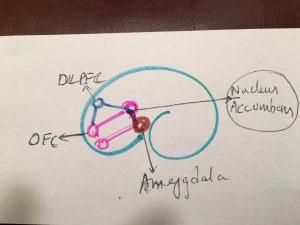Often at school and home alike, we see children perform variably across tasks. Countless times, teachers and parents ask me to help them understand why they are super good at video games or mind-craft type of activities, but not at things that require effort such as homework and if the problem is real. There may be many reasons, but one concept is overarching that requires a quick explanation. That is on the topic of motivation versus effort that is required.
If you like and want something, amygdala signals pleasure and talks to the area that signals the anticipatory excitement of reward (nucleus accumbens: Important area noted in my drawing), and the CEO of motivation (orbitofrontal cortex, OFC) lets you engage in the reward based activity that you love and get excited about! Dorso lateral  prefrontal cortex (DLPFC) is connected to OFC and cooperates in executing the task that is fun.
prefrontal cortex (DLPFC) is connected to OFC and cooperates in executing the task that is fun.
But if you have to expend effort and drag yourself to do inherently difficult work, and if there is not enough joy or excitement (and no extra push at the amygdala or nucleus accumbens), the region that needs to execute effortful task i.e., the CEO of the decision making (DLPFC) needs to be heavily recruited. It becomes important that DLPFC works harder! If there are attentional difficulties, it is easier to execute tasks that are driven by reward and are fun, but not where more effort is needed and where tasks require more concentration.
If there is any type of resistance, I often ask parents and teachers to:
- Remind them of the fun- feeling on successful completion of any task (because gently influencing their thinking will lead to reaping rewards in the long run)
- Chopping tasks down to easy-peasy bits to ensure they can be completed with much less effort
- Recruit extra tutoring to teach them to learn through extra training to make it much more easier to accomplish tasks that require effort
- In school, it may mean looking forward to rewards from the teacher. I generally think, while concrete rewards like small prizes may be good, simple praise for good work and joy in teacher’s face will go very far. That way, it is simple and achievable. At home, it is good to offer favorite food on the side, before-during-or after homework- based on the parent-child preference to make the homework time generally an extra positive one (and be kind around that time than nag/lecture). This is especially important after-school as “hungry man is an angry man.”
- You have to consciously teach the kids that extra practice will help them a lot and makes anything easier and that it all takes TIME.
Remember, what appear to be very simple and logical solutions listed above have also the very logical underlying brain operations under play if you pair them with the explanations! If you understand the process, you will be more forgiving. You understand that they are not “lazy” or “playing games” with you, but yielding to the default of easy or fun tasks. You can help address “the real problem!”















